Top Free Cloud Storage Services for 2015
In this era, technology has provided us with convenience in every walk of life. Today, we can store our files online and get access to them from pretty much anywhere we go, without having to carry a USB flash drive or any other device with us.This has also significantly reduced the risk of losing important documents in case of theft or uncertain situations. So instead of emailing files to multiple people, cloud storage has enabled people to simply send links of the files, which saves a lot of time.It also allows people to recover files in case they lose them. With so many options for cloud storage available we have selected a few below which we think are the best choices of cloud storage for 2015.Dropbox

Dropbox gives you 2GB of free storage once you sign up. It can be further increased to 18GB by following a few easy steps. One of the best things about Dropbox is the fact that it allows you to share files with people who haven’t registered or made an account on it. Therefore, anyone can conveniently download and share files that you upload. You can have full confidence while uploading files to Dropbox because it backs them up with full security. All in all Dropbox is an amazing place to store your photos, music and files.
Google Drive

Through Google drive sharing, editing and uploading files among people has become really easy. Google drive comes with storage of 15GB once you sign up for a Gmail account. It keeps on saving the changes you make on a spreadsheet document to save time and keep you from losing precious data. You can give certain people permission to edit documents and keep certain people from making any changes at all. Google drive is the perfect pick for you if you want to share multiple files among your employees or co-workers.
Mega

Mega gives you a free storage of 50GB. Yes, that’s correct. What makes Mega stand out is the fact that whenever you upload or download data to it or from it, it’s encrypted or decrypted. Unlike Google drive, mega keeps anyone else from accessing your data. So, if what you’re looking for is security and privacy, then Mega is without a doubt the best pick for you.
One Drive

Like Google drive, OneDrive also gives you a free storage of 15GB. The best thing about OneDrive is that it helps you sleep soundly at night; because once you download OneDrive on your PC it automatically backs up your files, photos and music. You can also use OneDrive to back your files up from your phone, tablet and laptop. Therefore, OneDrive is pretty much a life saver.
Hive

Similar to torrent, hive is an app that gives you unlimited free storage. The beauty of hive is that you can stream files without actually having to download them, which saves a lot of time and storage space on your hard drive. Although, one of the drawbacks that hive has is the fact that you can’t share your files with other users or general public.
This article was written by Rida Maqbool, she blogs at http://www.mytechbits.com/, which is a premiere technology website.


